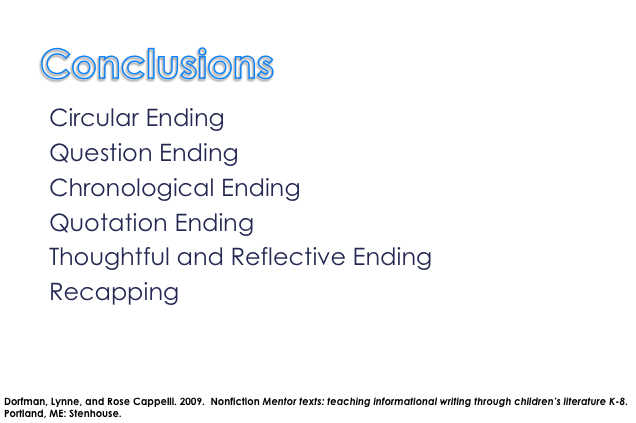Using Mentor Texts to Teach Craft and Structure in Writing
Presenter: Bridget Anderson
Presenter: Bridget Anderson
On October 24th, while attending the California Reading Association’s 48th, Joy of Literacy, Conference, I was fortunate to attend a session about the use of mentor texts with Bridget Anderson. A mentor text, simply put, is an example of outstanding writing, to be used to help “move the Whole Writer, rather than individual pieces of writing forward”. Bridget shared, “A mentor text can be a picture OR chapter book, newspaper OR magazine, as well as a brochure OR menu.”
Bridget very eloquently explains how to use mentor texts effectively and began her presentation with this quote:
“The first step in a writing lesson is not to write at all but to read a well-written text and analyze it!” Lori Oczkus
This is a quote that hooked me from the start of Bridget’s presentation. I have used Lori’s strategies for years as an educator with my own students and it was even more exciting to see her referenced in a session in which I was feeling very unfamiliar.
Once she hooked me, Bridget explained that the reason one would want to use mentor texts in their Literacy Instruction is that it is a necessary skill for an adolescent to be able to study models as a key element of his/her writing instruction. Students are no longer just being asked what is written in a text, rather now they are asked how a text is written. Basically, they are being taught to read like writers, and conversely, write like readers. Interestingly enough, the key standards for K-5 Reading are students are able to demonstrate an understanding of:
Key Ideas and details, which includes:
- Reading closely to determine what the text explicitly says; make inferences from, cite specific text evidence to support conclusions when Reading, Writing, AND Speaking
Craft and Structure, which includes:
- Interpret words or phrases
- Analyze the structure of texts
- Assess point of view or purpose
Integration of Knowledge and Ideas, which includes:
- Integrate and evaluate content presented
- Delineate and evaluate the argument
- Analyze two or more texts with similar themes
Bridget chose to focus on Craft and Structure standards with her approach to mentor texts. She takes two genres of writing: narrative and informational; and breaks down their structure for teachers and students.
Bridget points out that all narrative books have an intentional beginning structure.
In order to show the structure of such beginnings, Bridget brought in part of her own classroom library. We had the opportunity to read like a writer, by looking at the beginnings of different narrative books, then decide which structure the author chose to use to begin the story. Bridget then showcased different pieces of writing done in actual classrooms, which mimicked the structure of using one of the intentional beginnings. She showed whole class interactive writing, small group retellings, and individual student work.
As participants of the session, we again had the opportunity to read like writers with Bridget’s personal classroom library. We chose the structure in which we thought the author used to begin his/her informational book. After teaching these specific introductions by using text examples, a teacher could then do this activity with his/her students. For example, students can look at the beginning of the non-fiction text they are reading and decode on which introduction the author chose to begin with.
As you may have predicted, an author needs to plan their endings as well. Students often spend so much time telling their story or including information in their writing, that they lose stamina and just end their writing in a lackluster way. Bridget taught me the specific structures in which an author chooses from to end their book. Shown here:
We read like writers again and had a chance to look at non fiction writing pieces and see how the author chose to end his/her story. Bridget showed more examples of student writing in which they applied a particular chosen ending to a story or informational piece of writing.
Lastly, we had a chance to create a piece of non-fiction writing. We had an opportunity to work with a partner. She scaffolded our writing by having us think of a topic in which we know about, we chose baking cookies. We were then given 3 beginning structures to chose from to begin our story. We were quickly able to see how we had to decide what type of writing we were going to do in order to choose our beginning. Was it going to be a literary non-fiction in which we told of a time one of us actually baked cookies? Was it going to be more of a how- to book? Once we decided the style of writing, the rest of our writing could follow a certain structure.
I appreciated the way Bridget so clearly explained the structures of narrative and informational texts and used models of exemplary writing in order to show us how a mentor text can be used to move our students as writers. She not only gave us concrete models we can share with our colleagues, she gave implementation ideas as well. I came away from her session with a power point I can share with teachers, and a plan for writer’s notebooks or folders, anchor charts, and a broader collection of mentor text ideas.
Thank you Bridget!
If you would like to contact Bridget Anderson: banderson@rialto.k12.ca.us
~ Melissa West
No comments:
Post a Comment